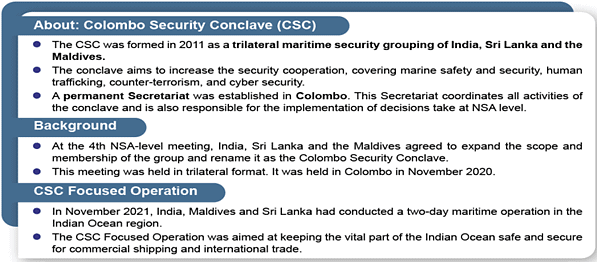Internal Security: March 2022 Current Affairs - UPSC PDF Download
India Accidentally Fires Missile Into Pakistan
India admitted the supersonic missile that landed in Pakistan was accidentally fired from one of its bases.
What Had Happened
- As per Pakistan, a high-speed flying object originating from the northern Indian city of Sirsa (Haryana) had crashed in eastern Pakistan.
- The object, flying at 40,000 feet and three times the speed of sound, had flown 124 km (77 miles) in Pakistani airspace.
- The missile was unarmed and had crashed near the country’s eastern city of Mian Channu, about 500 km from capital Islamabad.
Missile Used
- Neither country has spelt this out; Pakistan has only called it a “supersonic” missile.
- Some experts have speculated that it was a test of one of India’s top missiles, BrahMos, jointly developed with Russia.
(i) BrahMos has a top speed of Mach 3, a range of around 290 km, and a cruising altitude of 15 km (around 50,000 feet).
(ii) BrahMos can be fired from anywhere, is nuclear-capable, and can carry warheads of 200-300 kg. - Other experts have wondered if the missile was a variant of the nuclear-capable Prithvi. However, India never tests Prithvi around this region, and only does so from Balasore.

Extremely Alarming Incident
- This event is being widely seen as an extremely alarming incident that could have triggered a conflagration between the two nuclear-armed neighbours. The two nuclear-armed neighbours have fought wars in the past and they do not trust each other.
- It has also raised questions about safety mechanisms and the technical prowess of very dangerous weapon.
- The missile has several in-built locks and such accidental firing raises questions about safety protocols.
- Security analysts wondered if the incident meant that India had missiles in ready-to-launch positions and pointed at Pakistan. Hence, it will further raise suspicions about the intentions of India.
- The flight path of missile endangered many passenger flights both in Indian and Pakistani airspace as well as human life and property on ground.
53rd Raising Day Celebrations of CISF
- The Central Industrial Security Force (CISF) celebrated its 53rd Raising Day in Ghaziabad.
- While speaking at this occasion, Union Home Minister Amit Shah pitched for a hybrid security model.
- Hybrid Security Model Pitched By Home Minister
- In this model, the CISF would train and certify private security agencies.
- These private agencies can, then, take over the task of efficiently guarding various kinds of industrial and manufacturing units in the country.
- Under this model of security, the CISF will prepare the strategy and both private and the CISF personnel would work in synergy.
- The proposed hybrid security model will give space to the private security agencies.
- About Central Industrial Security Force (CISF)
- CISF is one of the Central Armed Police Forces (CAPFs) established under an Act of Parliament, “Central Industrial Security Force Act, 1968.
- CISF was established in 1969 to provide integrated security cover to certain sensitive public sector undertakings with a strength of only three battalions.The force has since grown into a premier multi-skilled organization with a present strength of 1,63,590 personnel.
- Eventually, it was made an armed force of the Republic of India by another Act of Parliament passed in June 1983. It works under the administrative control of Ministry of Home Affairs and its headquarter is located at New Delhi.
- It secured the private manufacturing production units as India rode on to become a $2.5 trillion-strong economy. CISF has to play an important role in country's journey from a $2.5 trillion economy to becoming a $5 trillion economy


Need To Remain Prepared For The Future Challenges
- CISF been asked to prepare a 25-year road map so that it can emerge as a result-oriented security agency by the time India enters the 100th year of its independence.
- In the past, there has been increase in the drone threats to industrial units along sea ports and the land border.
- Hence, the CISF needs to effectively collaborate with agencies like DRDO and the BSF to prepare an effective counter-technology against this menace.
- The CISF needs to explore ways so that the representation of women personnel in the force could be enhanced from the present 6% to 20%.
Colombo Security Conclave
The fifth meeting of national security advisers of the Colombo Security Conclave (CSC) was held in the Maldives.
India was represented by NSA Doval.
Key Highlights of the meeting
1. Participating Members
The conclave was attended by the Maldives, India and Sri Lanka, and the newest member of the Conclave, Mauritius.
- At this meeting, Mauritius was included as the fourth member.
- Delegations from Bangladesh and Seychelles participated as Observers.
2. Road Map For Cooperation Adopted
- The meeting adopted a road map for cooperation and collaboration in areas such as maritime security, counterterrorism and drug trafficking.
- The roadmap will facilitate robust mechanisms for coordinated responses, capacity building and strengthening information flow.
3. Five Broad Areas Of Cooperation Identified
Conclave identified 5 broad areas of cooperation to strengthen regional security. These are:

4. Commitment To Achieve Regional Peace And Security
As maritime neighbours, facing similar threats, the Conclave reaffirmed their commitment to engage in consistent joint efforts to achieving regional peace and security.
5. India’s Stand At The Conclave
- NSA Doval said the conclave should institutionalise its cooperation with a road map.
- It should also form joint working groups to tackle drug trafficking and cybersecurity challenges.
- Members of the grouping remain vulnerable to trafficking, organised crime and maritime terrorism, particularly in the light of the developments in Afghanistan.
- He called for strengthening cooperation amongst maritime neighbours to address shared security challenges, and as first responders.
- India also proposed a meeting of the Heads of respective Coast Guards this year.

Significance
- This India-driven mini-lateral grouping is being seen as India’s outreach to the Indian Ocean to underline regional co-operation and shared security objectives.
- CSC hopes to restrict China’s influence in an area of strategic importance, and to reduce the Chinese footprint in the member countries.
- Country’s national security is deeply intertwined with the collective security aspirations in the Indian Ocean Region.
- Geographical proximity of the member countries allows them to be first responders for each other in crisis situations. E.g., Indian Coast Guard helped douse the MT New Diamond and X-press Pearl ship fires in Sri Lankan waters
In this context, CSC is being described as the region’s 911 (the number "911" is the universal emergency number in the United States).
Joint Declaration On Privacy and Protection of Personal Data
 |
Download the notes
Internal Security: March 2022 Current Affairs
|
Download as PDF |
- European Union along with 9 other countries, including India, has called for international cooperation with the aim to promote data protection and the standards of privacy.
- The other countries are - Australia, Comoros, Japan, Mauritius, New Zealand, Republic of Korea, Singapore, Sri Lanka.
Key Highlights
- International cooperation to promote high data protection & privacy standards would be based on:
(i) Comprehensive legal frameworks and policies covering both the private and public sectors;
(ii) Core principles such as lawfulness, fairness, transparency, purpose limitation, data minimisation, limited data retention, data security and accountability;
(iii) Enforceable rights of individuals, such as access, rectification, deletion, and safeguards with respect to automated decision-making such as transparency and the possibility to challenge the outcome;
(iv) Safeguards for international transfers to enable cross-border data flows by ensuring that the protection travels with the data;
(v) Independent oversight by a dedicated supervisory authority and effective redress. - The aim is to create a world where data moves easily between jurisdictions, in compliance with the relevant applicable legal frameworks, among supervisory authorities across borders.
Assam-Meghalaya Border Pact
Assam and Meghalaya have partially resolved a 50-year-old border dispute in six of the 12 sectors along their 885-km boundary.
What Has Been Agreed Upon
- Out of the disputed 36.79 sq. km land, Assam will get 18.51 sq. km of the disputed areas and Meghalaya will get the remaining 18.28 sq.km.
- About 70% of the inter-State boundary has now become dispute-free with the signing of the agreement.
- The problem in the six other areas will be resolved in the near future.
- Remaining Six-Disputed Sectors Between These Two States
(i) Tarabari, Gizang, Hahim, Boklapara, Khanapara-Pillangkata and Ratacherra under the Kamrup, Kamrup (Metro) and Cachar districts of Assam and
(ii) West Khasi Hills, Ri-Bhoi and East Jaintia Hills districts of Meghalaya.
What Lies Ahead
- The freshly demarcated border will have to be passed by Parliament by amending the North Eastern Region (reorganisation) Act, 1971.
- This will then have to be ratified by the legislative assemblies of both the states.
Background
- Meghalaya was carved out of Assam under the Assam Reorganisation Act, 1971. This act has been challenged by both the parties which led to the boundary dispute.
- There were 12 points of dispute along their borders. These include the areas of:
- Upper Tarabari, Gazang reserve forest, Hahim, Langpih, Borduar, Boklapara, Nongwah, Matamur, Khanapara-Pilangkata, Deshdemoreah Block I and Block II, Khanduli and Retacherra.
- The two States had in June 2021 adopted a give-and-take policy to start the process of resolving the boundary dispute. For this, they constituted three regional committees each.
- The current draft resolution was prepared on the basis of recommendations of these regional panels.
- It had proposed dividing the disputed 36.79 sq. km land in the six areas of difference between the two States.
FAQs on Internal Security: March 2022 Current Affairs - UPSC
| 1. What happened during the 53rd Raising Day Celebrations of CISF? |  |
| 2. What is the Colombo Security Conclave? |  |
| 3. What does the Joint Declaration on Privacy and Protection of Personal Data signify? |  |
| 4. What does the Assam-Meghalaya Border Pact entail? |  |
| 5. What are the key aspects of the March 2022 Internal Security Current Affairs? |  |





















